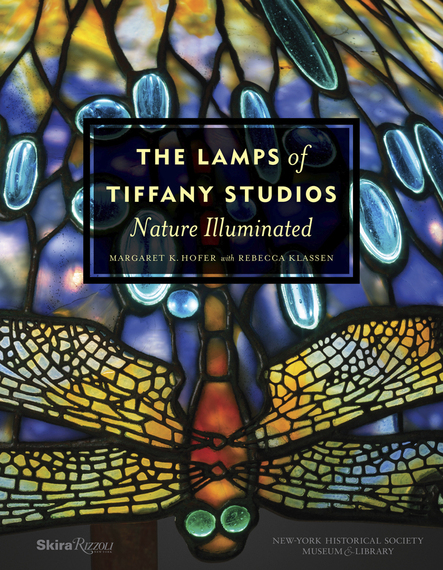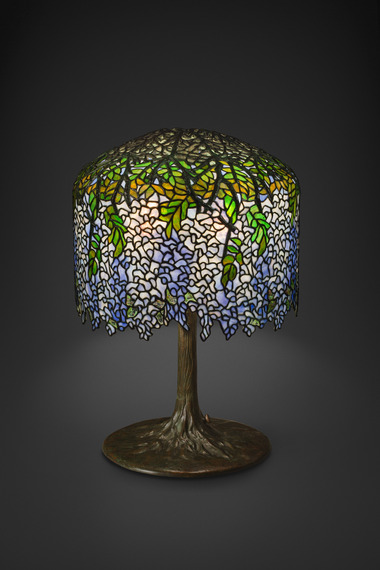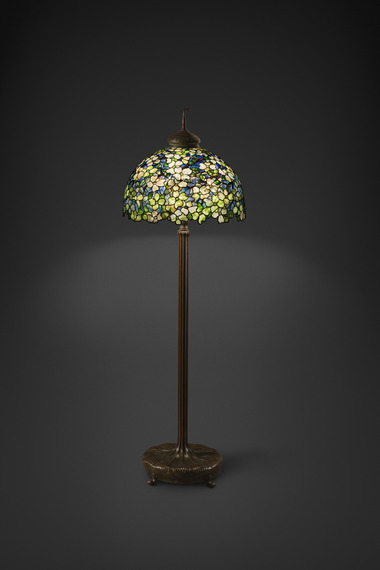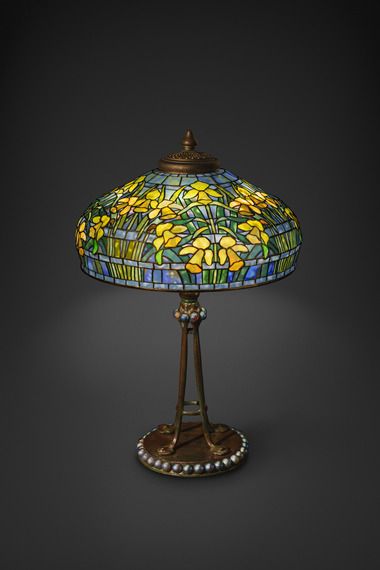A new book from Rizzoli looks at 100 Tiffany lamps and the critical role that one woman played in creating them.

The Lamps of Tiffany Studios: Nature Illuminated
Clara Driscoll was Louis Comfort Tiffany's lead lamp designer and the shepherd of 35 "Tiffany's Girls" - the young women who selected and cut glass for each shade. Some of the lamps were one-of-a-kind, but others were made in multiples.
"They could make as many as 400 of one lamp," says Margaret K. Hofer, vice president and museum director at the New York Historical Society. Hofer and assistant curator Rebecca Klassen have assembled a new exhibition of lamps, now on display in one of the society's museum galleries.

Wisteria, Tiffany Studios
Among them is the exquisite, Driscoll-designed Wisteria lamp, composed with 2,000 pieces of glass that twist and curl with grace.
"It was one she discussed in her letters, so we know she designed it around 1901," she says. Hofer thoroughly researched two collections of Driscoll's letters - one at Kent State University, and another at the Queens Historical Society.

Dogwood, Tiffany Studios
The lamps on display and in the book (with photography by Colin Cooke) came from those collected by Egon Neustadt, who began picking them up in 1935. "They were dismissed as hopelessly out of fashion at a time of American modernism," she says. "They were an anathema."
Neustadt collected them through the 1980s, becoming obsessed as he sought to amass an encyclopedic collection. "His first lamp cost him $12.50, but by 1984 he was paying much more," she says. "Today they can reach into seven figures."

Daffodil, Tiffany Studios
Clara Driscoll certainly would look at those prices in amazement. The lamps of her design originally sold at prices ranging from $30 to $750, with Wisteria fetching $400. And while Driscoll herself earned $35 a week, "Tiffany's Girls" starting out as glass cutters earned $7.50.
Some made more, though marriage could put an end to that. In one of Driscoll's letters, she writes of one woman who came to her and announced her engagement - and her departure. "And she was making more than her fiancé - $12.50 versus five or six dollars," she says. "It wasn't questioned that you left work when you got married."
Times - like the price of a Tiffany lamp - have definitely changed.
J. Michael Welton writes about architecture, art and design for national and international publications, and edits Architects + Artisans, where portions of this post first appeared. He is architecture critic for the News & Observer in Raleigh, N.C., and the author of "Drawing from Practice: Architects and the Meaning of Freehand" (Routledge, 2015)
Support HuffPost
Our 2024 Coverage Needs You
Your Loyalty Means The World To Us
At HuffPost, we believe that everyone needs high-quality journalism, but we understand that not everyone can afford to pay for expensive news subscriptions. That is why we are committed to providing deeply reported, carefully fact-checked news that is freely accessible to everyone.
Whether you come to HuffPost for updates on the 2024 presidential race, hard-hitting investigations into critical issues facing our country today, or trending stories that make you laugh, we appreciate you. The truth is, news costs money to produce, and we are proud that we have never put our stories behind an expensive paywall.
Would you join us to help keep our stories free for all? Your contribution of as little as $2 will go a long way.
Can't afford to donate? Support HuffPost by creating a free account and log in while you read.
As Americans head to the polls in 2024, the very future of our country is at stake. At HuffPost, we believe that a free press is critical to creating well-informed voters. That's why our journalism is free for everyone, even though other newsrooms retreat behind expensive paywalls.
Our journalists will continue to cover the twists and turns during this historic presidential election. With your help, we'll bring you hard-hitting investigations, well-researched analysis and timely takes you can't find elsewhere. Reporting in this current political climate is a responsibility we do not take lightly, and we thank you for your support.
Contribute as little as $2 to keep our news free for all.
Can't afford to donate? Support HuffPost by creating a free account and log in while you read.
Dear HuffPost Reader
Thank you for your past contribution to HuffPost. We are sincerely grateful for readers like you who help us ensure that we can keep our journalism free for everyone.
The stakes are high this year, and our 2024 coverage could use continued support. Would you consider becoming a regular HuffPost contributor?
Dear HuffPost Reader
Thank you for your past contribution to HuffPost. We are sincerely grateful for readers like you who help us ensure that we can keep our journalism free for everyone.
The stakes are high this year, and our 2024 coverage could use continued support. If circumstances have changed since you last contributed, we hope you’ll consider contributing to HuffPost once more.
Already contributed? Log in to hide these messages.



